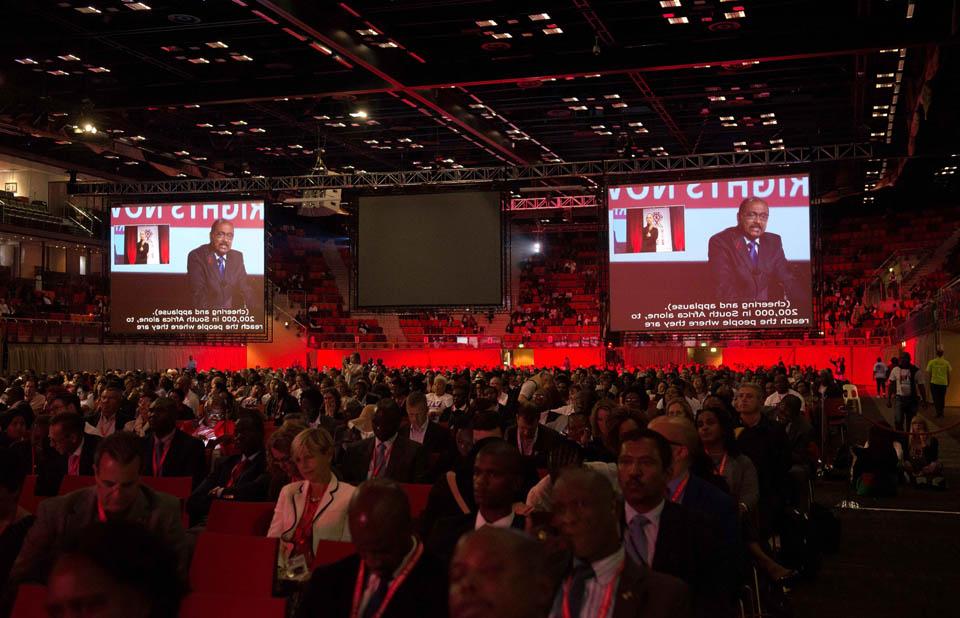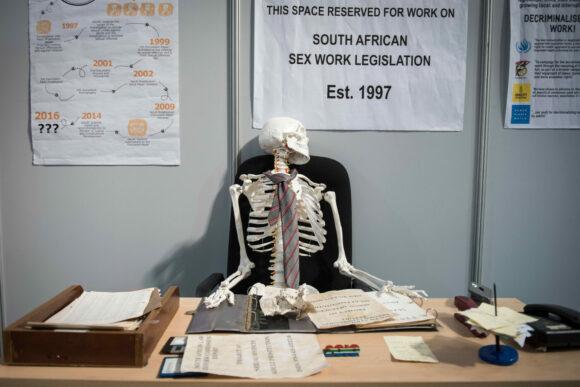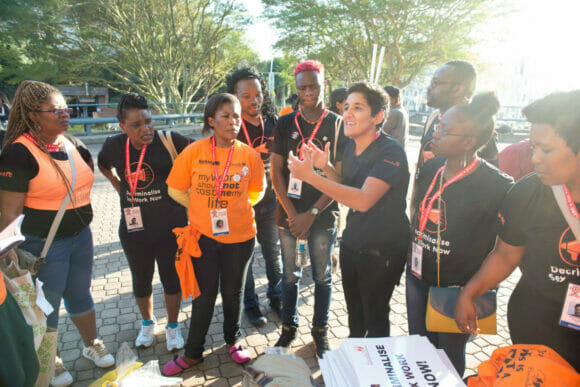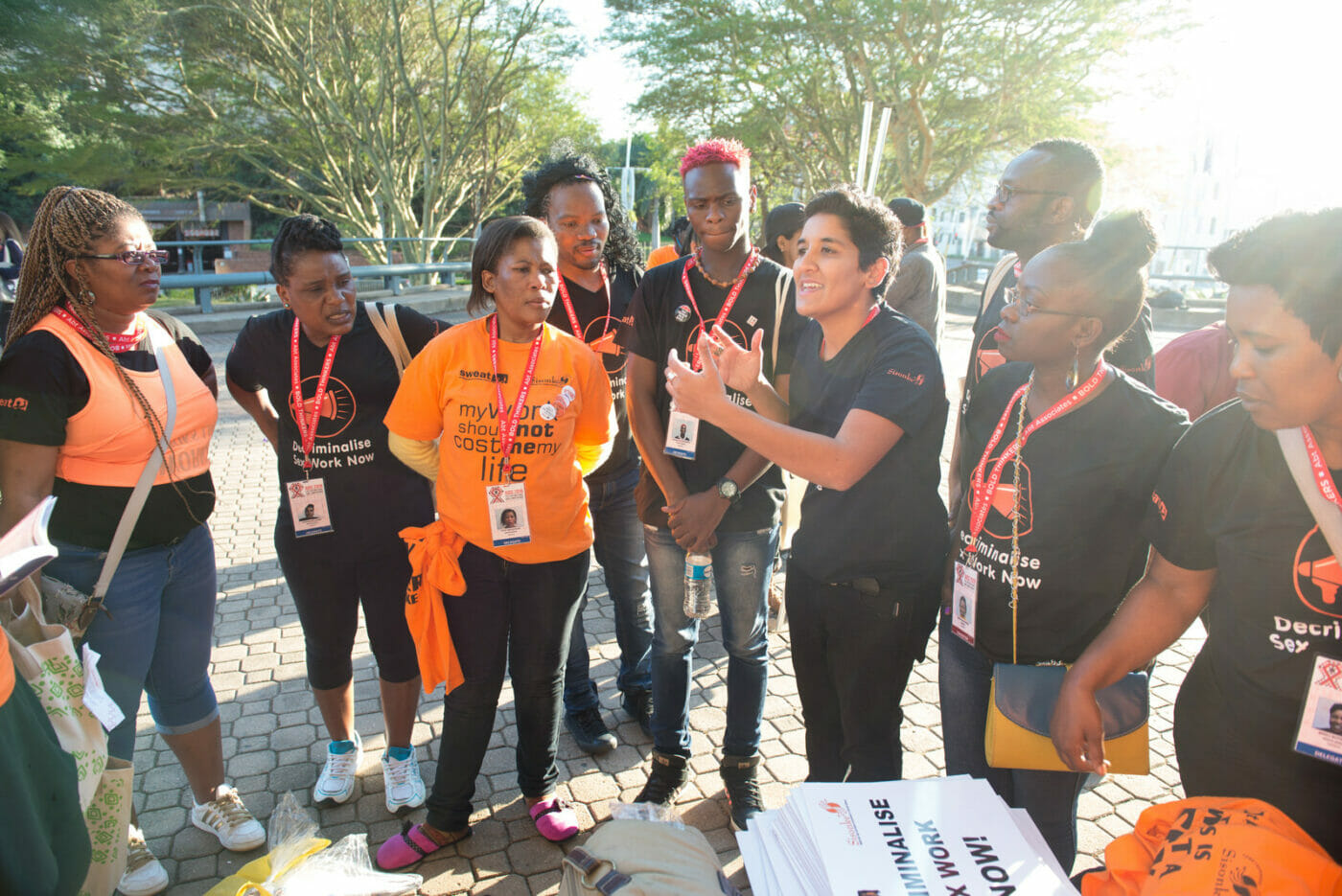Discover how one organization harnessed the power of artistic activism to revolutionize the sex worker movement in South Africa.
From fake political campaigns to skeleton bureaucrats, learn how artistic activism can effect policy, shift narratives, and inspire change. Dive into the story of how SWEAT’s collaboration with the Center for Artistic Activism led to groundbreaking results, and explore six key ways that artistic activism can transform social movements.

Background

In 2015, Ishtar Lakhani met the Center for Artistic Activism for the first time. At the time, she was working as an Advocacy Manager at the Sex Workers Education and Advocacy Task Force (SWEAT). The Open Society Foundation (OSF) had brought the Center to Cape Town to organize a five-day workshop for organizations involved with the Sex Worker Movement in South Africa.
Training
The Center for Artistic Activism led a workshop called the School of Creative Activism, which gave participants a deeper understanding of the history and theory behind creative activism practices. It brought together members of organizations from other regions in the country who did not know each other’s work and it connected members of the movement, laying the groundwork for future collaborations.
One of the SWEAT team’s highlights was developing a 24-hour creative activism action with organizations from across the country. The activity inspired and united them, giving them a common language, a sense of urgency, and solidarity.
Ishtar describes the experience as eye-opening and enlightening. The training gave her team a new level of investment and commitment to artistic activism. This training was much more transformative than several others the organization had been part of, after which people often returned to work as usual.
The experience made SWEAT a lifelong fan of the Center for Artistic Activism’s methods. After the workshop, the Center offered mentorship to workshop participants, and SWEAT signed up for this opportunity.
Through this mentorship, SWEAT and the Center maintained a close relationship, with regular brainstorming calls and meetings.
In 2016, the two organizations received funding to attend the 21st International AIDS Conference (AIDS 2016) in Durban, South Africa. This allowed them to work closely, building on their previous collaboration.
Collaboration

In 2016, the Center received funding to attend the 21st International AIDS Conference (AIDS 2016) in Durban, South Africa, which allowed SWEAT to work closely with the Center.
The Desk of Disappointment

Several of the actions around the 2016 AIDS Conference centered on getting the South African Law Reform Commission to release a report. The report in question had been delayed for decades, which in turned stalled the movement for law reforms impacting sex work.
SWEAT targeted the Deputy Minister of Justice with The Desk of Disappointment, aiming to embarrass him about the stalling of the report. It consisted of a skeleton wearing a tie, sitting on a desk, in front of a sign that read “This space is reserved for work on South African Sex Work Legislation“.
The report was released within a year.
Along with other actions deployed during the 2016 AIDS Conference, the creative activism tactics pressured the Deputy Minister and led to a major win. This was a significant victory for the movement, and it demonstrated the impact of the Center for Artistic Activism’s methods.
Changing the Conversation with a sign and an Umbrella
One of the most potent actions developed during the Conference changed the conversation on Sex Work during the event. The remarkable thing is that, aside from the creative process, it only required a sign and an umbrella.
Steve Lambert shares the story of this action in his presentation “From Anger to Utopia” at the frank Conference in 2020.
The Elton John Award
During the 2016 AIDS Conference, Sisonke — a nation-wide movement formed by sex workers for sex workers — wanted to meet with representatives of the Elton John AIDS Foundation, well-known for supporting Sex Work and HIV+ organizations.
Sisonke had struggled to get the Elton John AIDS Foundation’s attention, so they devised a creative strategy. They created the Elton John Award to recognize the singer and his Foundation’s role in supporting the movement.
The action led to a meeting between Sisonke and Elton John himself. It also began a relationship the Elton John AIDS Foundation after the conference This breakthrough that would have been impossible without the creative strategy.
Although the meeting did not result in immediate funding, it demonstrated the potential of creative activism to position organizations for better access to funds and greater visibility with funders.
One more: A Sex Worker for President

In the 2019 South African Presidential Elections, a SWEAT initiative ran a fake political campaign for a sex worker president. The organization called itself the Sex Worker Action Group (SWAG) and the effort was inspired by previous campaigns in Brazil.
SWAG created posters that were both official-looking and playful. The group expected some backlash, but instead, they received an outpouring of support on social media. People were hungry for an alternative. This impacted how people viewed sex workers and sex work.
The action had a tangible impact on the election, as the two opposition parties — the Democratic Alliance and the Economic Freedom Fighters — included sex worker rights in their manifestos for the first time.
This was an unprecedented breakthrough, and a significant milestone in the movement.
What can Artistic Activism do?
The story of SWEAT shows us that artistic activism, as a collective creative process, brings people together and strengthens bonds between people and organizations. It can also help to accomplish the following:
1. Changing the narrative
The creative activism actions during the AIDS Conference changed the conversation on Sex Work and Sex Worker’s rights. SWEAT and other activists shifted the narrative from one that kept sex and sex workers invisible to one that recognized sex work overtly and as a valid
policy topic within decision-making spaces. The impact of this narrative shift was lasting and profound. It strengthened the movement and paved the way for future policy changes.
2. Effecting Policy
Creative activism can effect policy by creatively and festively pressuring public officials to speak the previously unspeakable. For example, that sex work is a valid activity and sex workers are important actors within a policy arena. Creative activism can also influence policy by using creative and festive tactics to pressure public officials. Using surprise and unexpected approaches, advocates can open new conversations and signal alternative futures (a sex worker could be president!). Creative activists generate compelling images, such as a skeleton bureaucrat halting policy change, to bring emotion and affective experiences into policy worlds. This shakes up public discourse and sparks action.
3. Impacting activist organization’s tactics
All the creative activist actions listed above were designed and implemented by organized sex workers.
SWEAT and many other organizations within Sisonke, the National Sex Worker Movement, are run by sex workers or workers in the sex industry. As a result, we can see the direct impact of the Center’s training on the sex worker movement in South Africa.
Sex workers outside of the organized movement face numerous challenges, including criminalization, underemployment, and harassment. As a result, they may not feel the impact of creative activism as strongly. But for those directly involved in Sex Worker activism, creative activism was a game changer.
“[it] definitely changed how the Sex Worker Movement does its activism, thinks about activism, and thinks about how to impact change.”
According to Ishtar, SWEAT’s work on creative activism has “definitely changed how the Sex Worker Movement does its activism, thinks about activism, and thinks about how to impact change.”
4. Reducing costs (creative activism is cheaper) and securing funds
One of the key benefits of creative activism is its cost-effectiveness. Artistic activists can achieve their goals at a lower cost than traditional methods, which motivates funders to support their work.

SWEAT’s creative activism efforts paid off when they made the front page of the news after the opening night of the international AIDS Conference. The cost? A simple sign and umbrella.
In contrast, more expensive actions that mobilized 1,000 people barely received any news coverage.
In Ishtar’s experience, organizations often need to convince organization directors and funders on why to invest on creative activism. SWEAT spent five years gathering evidence and stories of success, which they used to convince top decision-makers of the effectiveness of
creative activism. And because a lot of these actions took place in a short time, they produced direct evidence of impact.
Ishtar successfully secured a significant budget line item of 300,000 Rand (approximately 15,000 USD) for “Creative Activism” in the OSF budget. This was a major achievement, supported by the organization, because they had witnessed the impact of creative activism in their advocacy.
The creative activist actions had enabled this level of support, and the validation had a profound effect on SWEAT. The organization became a model for Sex Worker Activism, with their work being showcased as an example for other grantees.
In other spaces and conferences, our work would come up. For example, the OSEP South Africa Director would always use SWEAT’s actions as creative and innovative examples.
5. Influence other activists in the field
The actions during the 2016 AIDS Conference impact on other AIDS Conferences that came after. For example, the next conference in Thailand included an action by local sex workers’ organizations featuring a jail cell, complete with police officers that would frisk the passing public, making people feel what criminalization is like.
The international Sex Worker’s movement tends to be creative (See the experience of the Sex Workers Opera, for example). Howerever, by using gameshows, talkshows and other installations, SWEAT ramped up expectations. This raised the bar for future conferences and set a new standard for the movement, which has continued to inspire creativity and innovation.

Ishtar notes a clear connection between the creative activism efforts in South Africa and the subsequent actions taken at other conferences and events. While SWEAT cannot claim direct responsibility for these actions, they recognize that their work has inspired and validated local adaptations of creative activism tactics.
This is a testament to the power of creative activism to inspire and mobilize others. By sharing their experiences and strategies, SWEAT has helped to create a ripple effect of creativity and innovation within the movement.
6. Attention of funders
According to Ishtar, the 2016 Conference was a pivotal movement for the organization and the movement in general, as they took their creative activism to a new stage. It also made it possible for other organizations to witness the power and impact of creative activism.
The 2016 Conference also provided a platform for other organizations to witness the power and impact of creative activism. This exposure had a significant effect, as some of SWEAT’s actions made headlines and caught the attention of funders.
As a result, funders began to take notice of the impact and benefits of artistic activism, leading to increased support and recognition for the movement.
SWEAT was used as a model for other organizations. The public attention validated the impact of the actions and creative activism in general, turning an extravagant and unconventional possibility into a realistic and effective strategy.




You must be logged in to post a comment.